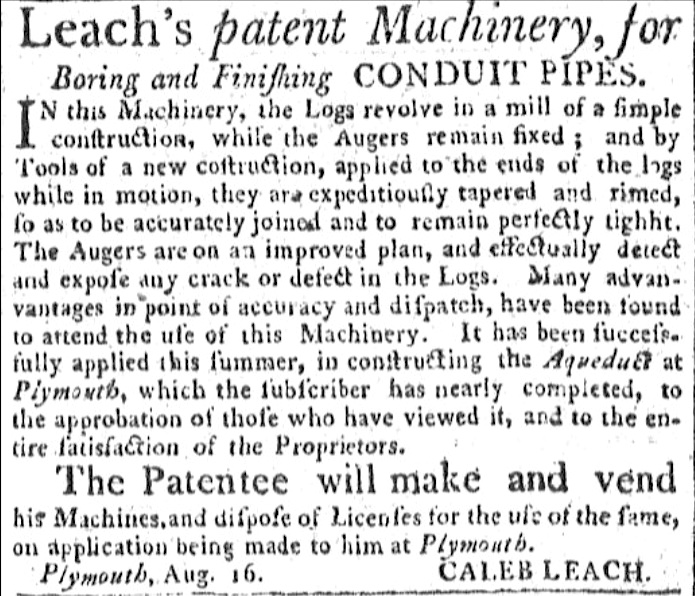In 1797 clock-maker Caleb Leach was granted one of the earliest woodworking machinery patents, a machine for boring wooden pump-rods that includes an auger bit for boring wood, which is possibly the first time such a bit was used. In the same year he designed and built a machine for cutting and heading nails, which could make 5000 nails per day. Leach was certainly a mechanic and inventor. We do not know if he manufactured his inventions, or if he licensed them to others. In 1796 Leach built the first public water system in the United States, in Owego, NY. Following that success, in 1797 he built the Manhattan water-works. In August 1797 Leach was advertising his patent machine plus licenses to operate it. The ad makes clear that Leach was the manufacturer.
 |
| Ad from 1797-08-16 Columbian Centinel, page 3 |
Information Sources
- The 1797 American Gazetteer, in a paragraph dealing with the manufacture of nails: "The machine invented by Caleb Leach, Plymouth, will cut and head 5,000 nails in a day, under the direction of a youth of either sex."
- 1815 Collections of the Massachusetts Historical Society, Second Series Vol. III, page 170: "An Aqueduct supplies the houses north of the Brook with water from Billington sea. This work was performed by Mr. Caleb Leach, who then lived in Plymouth, now of Oswego, New York, whose talents, as a self-taught mechanick, are of the very first order…” A footnote adds, “The orrery of Brown University was constructed by Mr. Leach, at Plymouth, for Dr. Forbes."
- A 1907 history of Owego, NY, Early Owego by LeRoy Wilson Kingman, includes a biography of Caleb Leach.
- February 1921 Proceedings of the Massachusetts Historical Society, page 193, in a list of recent acquisitions: "From Captain Philip Leach, U.S.N., a photostat of the letters patent, granted on April 13, 1797, to Caleb Leach of Plymouth, for invention of machinery for boring and finishing wooden conduit pipes." We contacted the MHS who provided us, for a fee, with high resolution scans of this patent specification. We have made a 3-page PDF available with the patent specification; see the Publications tab, above.
- California's Huntington Library has a box of Caleb Leach's papers. We have not seen these papers.
- The Metropolitan Museum of Art has a clock made by Caleb Leach in its collection. Photos are available online.